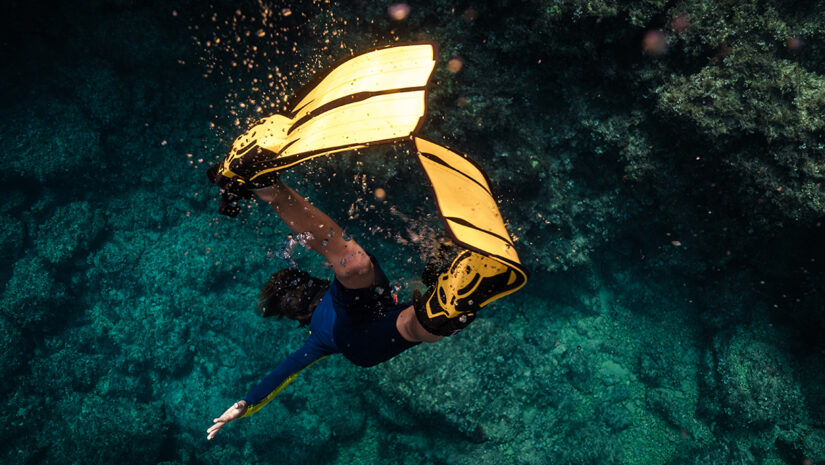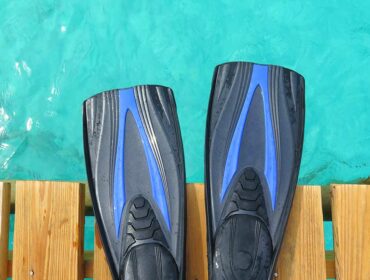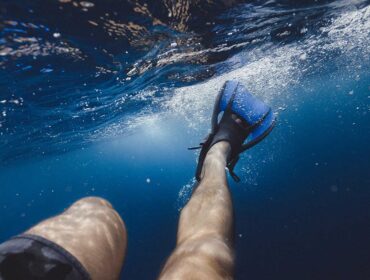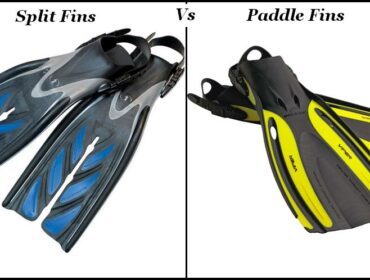Fins are all simple but instrumental pieces of Scuba diving gear that any water-lover should own. As we’ve seen in an earlier post, fins have evolved from bare, simple, stiff plastic, composite, or rubber paddle blade fins to several new and improved designs that offer different levels of efficiency and function. The sheer variety of fins out there today is mind-boggling.
Your choice of fins should depend on what type of diving or water activity you wish to use it for and the conditions you’re likely to face.
Swimming/Snorkeling Fins
If you’re a swimmer/snorkeler, a simple basic fin design will meet your needs. You need to remember that less is more and stick to a shorter blade than if you were scuba diving, as at the surface, a longer blade fin will prove to be more of a hindrance than help. The Aqua Sphere Zip Fins pictured right is a good example of a basic swimming or snorkeling fin.
Scuba Diving Fins
Scuba diving fins have the most variations and designs. They have longer blades than the swim fins we saw above, and you require more propulsion underwater when diving. The fin’s efficiency is much more critical to divers as the leg strength and power they use to kick effectively influence the energy spent and, in turn, air consumption. Maneuverability pivots and precise movements underwater are other things a diver should look for in a pair of fins. The Mares Avanti Superchannel Full Foot Fins pictured left exemplify scuba fins.
Free Diving Fins
Free diving fins are considerably longer than swimming/snorkeling and scuba diving fins to move the diver the most significant distance with the least amount of kicks. The long blades of these types of fins offer more resistance but are designed for more power and speed than maneuverability. The Cressi Gara 3000 LD Fins pictured right exemplify free diving fins.
Open Heel Fins Vs Full Foot Fins/ Close-heeled Fins
Open-heeled fins or half-pocket fins enclose the front portion of your foot, and a heel strap is used to secure the fit to your foot. The heel strap on the open-heel pocket fins can be either adjustable or non-adjustable. Open-heel fins or half-pocket fins enclose the front portion of your foot, and a heel strap is used to secure the fit to your foot. While this type of fin can be worn barefoot, it is preferable and advisable to wear them over the proper size Dive booties (neoprene boots). If you are deep sea diving or planning to dive in cold water, you will want these types of fins that’ll allow you to wear dive boots to provide extra exposure protection from the cold.
Mares Avanti Quattro Open Heel Fins & Aeris Velocity Full Foot Fins
Also called full-foot pocket fins, the close-heeled fins enclose your entire foot just as a slipper encloses your foot. They are worn barefoot and have an opening at the end for your toes. Generally cheaper than open-heel fins, it’s essential to try them on and ensure they fit snugly, wherein you can still wiggle your toes. Too tight, and they can cut circulation and pinch your foot, resulting in blisters or chafes. They are too loose and can slip off your foot when you hit the water or kick.
Split fins
The Split fins design is where the fin blade is split into two parts by a lengthwise slit. Split-blade fins are more expensive and are said to offer slightly better propulsion and agility than the standard fins. However, some divers believe they are less effective than conventional fins in strong currents. These fins are a good option for those with muscle spasms in their legs. How they are designed with an empty space down the blade’s center causes water propulsion behind the diver. They’re are fine if you are planning on going in a single forward motion the entire time, however they aren’t ideal for those who wish to back track and/or take photographs. The Apollo Bio Fins Pro C-Series, pictured right, are the best-rated Split fins in the market today.
Click Here to see the pros and cons of Paddle Fins vs. split fins.
Fins With Channels
Channels help move the water across or through the fin, which allows the diver to move through the water quite rapidly. Channels increase the divers speed because they offer less surface area resistance in the water. Additionally, channels (depending upon their placement) offer extra fin flexibility, which means the fin can bend further and move more water with each kick cycle. For an example, see the Mares “Volo Power” Open Heel Fins with channels, pictured left.
When buying SCUBA Fins, look for a good fit and features that suit your diving needs. If your dive fins do not feel like an extension of your limbs, it could make for an uncomfortable dive experience.





